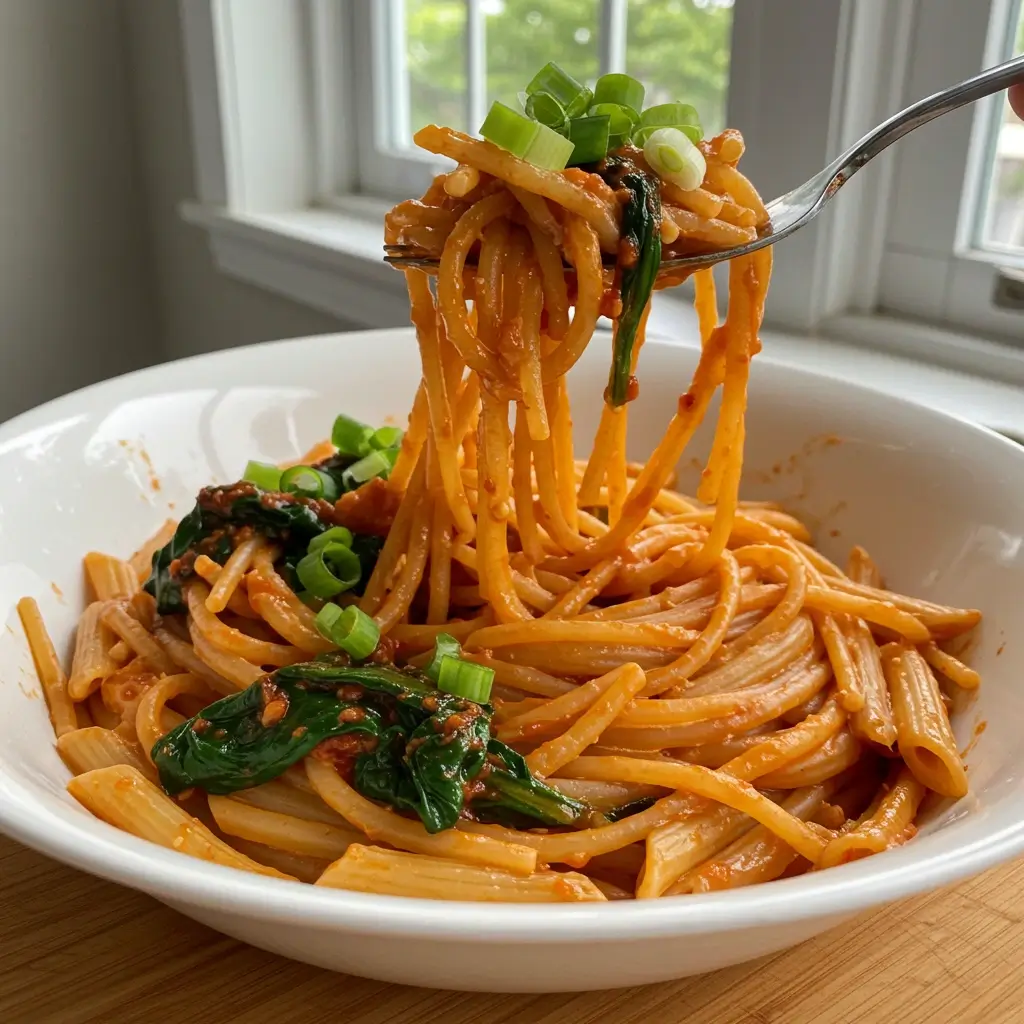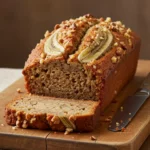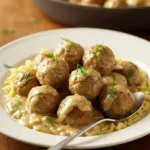The world of pasta is vast and varied, offering a canvas for endless culinary creativity. One of the latest trends captivating food enthusiasts is the fusion of traditional Italian pasta with the bold flavors of Korean cuisine. Enter the creamy gochujang pasta—a dish that beautifully marries the comforting texture of pasta with the spicy, umami-rich taste of gochujang. In this article, we’ll delve into the details of making this delightful dish, complete with a comprehensive guide on ingredients, nutritional information, serving suggestions, and more. Let’s embark on this gastronomic journey!
Ingredients
Creating a delectable creamy gochujang pasta requires a handful of ingredients that are likely already in your pantry or easily accessible at your local grocery store. Here’s what you’ll need:
- 8 oz pasta (any type)
- 1 cup heavy cream or coconut milk
- 2 tbsp gochujang (Korean chili paste)
- 2 cloves garlic, minced
- 1 tbsp olive oil
- 1 cup spinach, chopped
- Salt and pepper to taste
- 2 green onions, sliced for garnish
Instructions
Making creamy gochujang pasta is straightforward and takes a mere 20 minutes from start to finish. Follow these easy steps to create a meal that’s sure to impress:
- Boil Pasta:
- Begin by boiling your choice of pasta according to the package instructions. Once cooked, drain the pasta and set it aside.
- Sauté Garlic:
- In a pan, heat 1 tablespoon of olive oil over medium heat. Add the minced garlic and sauté until fragrant, ensuring not to burn it.
- Prepare the Sauce:
- Stir in 2 tablespoons of gochujang and your choice of 1 cup of heavy cream or coconut milk. Mix the ingredients well until the sauce is smooth and evenly combined.
- Add Spinach:
- Incorporate the chopped spinach into the sauce and cook until it wilts, enhancing the sauce with its vibrant color and nutrients.
- Combine Pasta and Sauce:
- Toss the cooked pasta into the sauce, ensuring it’s thoroughly coated. Season with salt and pepper to suit your taste preferences.
- Serve:
- Garnish with sliced green onions for a fresh, zesty finish. Serve the pasta warm, allowing the flavors to shine.
Nutrition Facts
Here’s a breakdown of the nutritional content per serving of creamy gochujang pasta:
- Calories: 450
- Protein: 10g
- Fat: 25g
- Carbohydrates: 50g
- Fiber: 2g
This dish is not only flavorful but also offers a balanced mix of macronutrients, making it a satisfying meal option.
How to Serve
Creamy gochujang pasta is a versatile dish that can be adapted to suit various occasions and preferences, making it a delightful addition to your culinary repertoire. Here are several ways to serve this flavorful pasta, ensuring that each meal is both satisfying and memorable:
As a Main Course
Serving creamy gochujang pasta as a standalone main course is one of the easiest and most rewarding options. The creamy sauce, infused with the rich and spicy notes of gochujang, creates a hearty dish that is perfect for quick weeknight dinners or leisurely weekend meals. To enhance the experience, consider garnishing the pasta with fresh herbs like cilantro or green onions, which add a burst of freshness and color. You can also sprinkle a bit of sesame seeds for a nutty crunch. This dish is not only filling but also allows you to enjoy the bold flavors without any distractions.
With Protein
Elevate your creamy gochujang pasta by pairing it with a protein of your choice. Grilled chicken, shrimp, or tofu are excellent options that not only enhance the nutritional profile of the meal but also add texture contrast. For instance, marinated grilled chicken can lend a smoky flavor that beautifully complements the creamy sauce, while sautéed shrimp can introduce a subtle sweetness. If you’re opting for tofu, consider using crispy, pan-fried tofu for a satisfying crunch. To prepare the protein, season it simply with salt, pepper, and a hint of garlic to keep the flavors balanced. Serve the protein on top or alongside the pasta for an eye-catching presentation.
Alongside a Salad
To create a balanced and refreshing meal, serve creamy gochujang pasta alongside a light, crisp salad. A salad can provide a contrast to the richness of the pasta, making the meal feel more complete and satisfying. Consider a simple mixed greens salad tossed with a tangy vinaigrette, or a refreshing cucumber salad with sesame dressing. Adding ingredients like cherry tomatoes, radishes, or avocado can introduce additional textures and flavors that complement the pasta. The crispness of the salad, combined with the creaminess of the pasta, results in a harmonious balance that will please your palate.
With a Side of Garlic Bread
No pasta dish is complete without a side of warm, crusty garlic bread. The aromatic, buttery goodness of garlic bread perfectly complements the creamy gochujang pasta, adding a delightful crunch that enhances the overall dining experience. To prepare garlic bread, simply spread a mixture of softened butter, minced garlic, and chopped parsley on slices of your favorite bread, then toast them until golden brown. The savory notes of the garlic will contrast beautifully with the rich, spicy pasta, making each bite a deliciously indulgent experience. You can even experiment with different types of bread, such as ciabatta or sourdough, to find your perfect pairing.
Additional Serving Suggestions
- Add Vegetables: For a more colorful plate, consider adding sautéed vegetables such as bell peppers, zucchini, or spinach. These not only enhance the nutritional value of the dish but also add vibrant colors and additional flavors.
- Toppings: Finish the dish with toppings such as crumbled feta cheese, toasted pine nuts, or a drizzle of chili oil for an extra kick. These toppings can elevate the dish further and provide a burst of flavor with every bite.
- Make It a Feast: For larger gatherings, consider serving creamy gochujang pasta as part of a multi-course meal. Pair it with an appetizer like spring rolls or dumplings, followed by a light dessert to cleanse the palate, such as sorbet or fruit salad.
By thoughtfully considering how to serve creamy gochujang pasta, you can create a memorable dining experience that caters to various tastes and occasions. Whether enjoyed solo or as part of a larger meal, this dish is sure to impress and satisfy.
Additional Tips for Making Creamy Gochujang Pasta
To ensure the best possible outcome when making creamy gochujang pasta, consider these comprehensive tips that will enhance the flavor, texture, and overall enjoyment of your dish:
Choose the Right Pasta
The choice of pasta is crucial in achieving the perfect creamy gochujang pasta. While many pasta types can be used, certain varieties tend to pair better with creamy sauces. Here are some recommendations:
- Fettuccine: This flat, ribbon-like pasta is excellent for clinging to creamy sauces. Its wide surface area allows for a hearty coating, making each bite rich and satisfying.
- Penne: The tubular shape of penne is perfect for holding onto bits of sauce. The ridges on the pasta help trap the creamy gochujang sauce, ensuring a flavorful experience in every mouthful.
- Spaghetti: A classic choice, spaghetti is versatile and can be easily twirled around a fork, making it a favorite for many. The long strands of spaghetti also work well with the creaminess of the sauce, providing a satisfying texture.
When selecting your pasta, consider the cooking time as well; fresh pasta will cook faster than dried pasta, so adjust your preparation accordingly to avoid overcooking.
Adjust Spice Levels
Gochujang, a staple in Korean cuisine, varies in heat intensity depending on the brand and age of the paste. To cater to your personal spice tolerance, follow these guidelines:
- Start Small: Begin by adding a teaspoon or less of gochujang to your sauce. This allows you to gauge the heat without overwhelming the dish.
- Taste and Adjust: After mixing the gochujang into your cream base, taste the sauce. If you desire more heat, gradually incorporate additional gochujang, mixing well and tasting after each addition until you reach your preferred spice level.
- Balancing Flavors: If you accidentally add too much gochujang, you can balance the heat with a touch of sweetness. A small amount of sugar, honey, or even a splash of apple cider vinegar can help mitigate the spiciness while enhancing the overall flavor profile.
Use Fresh Ingredients
Fresh, high-quality ingredients can dramatically elevate your creamy gochujang pasta. Here’s how to incorporate them effectively:
- Fresh Garlic: Instead of using pre-minced garlic, opt for fresh cloves. Minced or thinly sliced garlic sautéed in olive oil until golden brown adds a depth of flavor and aroma that enhances the dish significantly.
- Spinach: Adding fresh spinach not only boosts the dish’s nutritional value but also adds a vibrant color and texture. Sauté the spinach until just wilted before mixing it into the pasta; this will keep its bright green color and nutrients intact.
- Other Vegetables: Consider adding seasonal vegetables like bell peppers, zucchini, or mushrooms. These can be sautéed alongside the garlic to provide additional flavor and texture, making your dish even more wholesome.
Experiment with Creams
If you’re looking for alternatives to heavy cream, there are several options that can maintain the creaminess of your sauce while catering to dietary preferences:
- Coconut Milk: This dairy-free option is rich and creamy, making it an excellent substitute for heavy cream. It adds a subtle sweetness that can complement the spicy notes of gochujang. Full-fat coconut milk will provide the richest texture, while light coconut milk can be used for a lower-calorie option.
- Cashew Cream: Soak raw cashews in water for a few hours, then blend them with water until smooth. This creates a creamy base that’s both nutritious and versatile. You can season the cashew cream with salt and a squeeze of lemon juice to enhance its flavor, making it a great alternative for cream lovers.
- Greek Yogurt: For a tangy twist, consider using Greek yogurt. It adds creaminess and protein but should be added off the heat to prevent curdling. Stir it in at the end for a fresh taste that complements the gochujang beautifully.
Final Thoughts
By implementing these additional tips, you can maximize the flavor and enjoyment of your creamy gochujang pasta. Whether you’re adjusting the spice levels, selecting the right pasta, or experimenting with fresh ingredients and cream alternatives, these considerations will help you create a dish that is not only delicious but also tailored to your personal tastes. Happy cooking!
FAQs
Q: What is gochujang? A: Gochujang is a Korean chili paste made from fermented soybeans, red chili powder, glutinous rice, and salt. It has a rich, spicy, and slightly sweet flavor profile.
Q: Can I make this dish vegan? A: Absolutely! Substitute heavy cream with coconut milk and ensure your pasta is egg-free for a vegan-friendly version.
Q: Where can I find gochujang? A: Gochujang is commonly available in Asian grocery stores and many supermarkets. It’s also available online.
Q: How can I store leftovers? A: Store any leftovers in an airtight container in the refrigerator for up to three days. Reheat gently on the stove, adding a splash of water if necessary to loosen the sauce.
Q: Can I add other vegetables? A: Yes, feel free to add vegetables like bell peppers, mushrooms, or zucchini for extra flavor and nutrition.
Conclusion
Creamy gochujang pasta is a delightful fusion dish that combines the best of both Korean and Italian culinary worlds. Its creamy, spicy sauce paired with perfectly cooked pasta makes it a must-try for food enthusiasts and anyone looking to shake up their usual pasta routine. The rich, velvety texture of the sauce, combined with the fiery kick of gochujang, creates a unique flavor profile that’s both bold and comforting. The heat from the gochujang is balanced out by the creaminess, resulting in a dish that’s both spicy and smooth with every bite.
What makes this dish even more exciting is its versatility—you can easily tweak the level of spice by adjusting the amount of gochujang to suit your taste. Additionally, you can add vegetables, protein like chicken or shrimp, or even top it off with a fried egg for a more substantial meal. Whether you’re a fan of Korean flavors or simply love pasta, this dish has something for everyone.
With its simplicity, flavor, and versatility, creamy gochujang pasta is sure to become a staple in your recipe repertoire. It’s quick to make, but the flavor feels impressive enough for any occasion. Enjoy the bold flavors and relish in the compliments from family and friends as you serve up this delectable meal. Bon appétit!
Print
Creamy Gochujang Pasta Recipe
Ingredients
- 8 oz pasta (any type)
- 1 cup heavy cream or coconut milk
- 2 tbsp gochujang (Korean chili paste)
- 2 cloves garlic, minced
- 1 tbsp olive oil
- 1 cup spinach, chopped
- Salt and pepper to taste
- 2 green onions, sliced for garnish
Instructions
- Boil Pasta:
- Begin by boiling your choice of pasta according to the package instructions. Once cooked, drain the pasta and set it aside.
- Sauté Garlic:
- In a pan, heat 1 tablespoon of olive oil over medium heat. Add the minced garlic and sauté until fragrant, ensuring not to burn it.
- Prepare the Sauce:
- Stir in 2 tablespoons of gochujang and your choice of 1 cup of heavy cream or coconut milk. Mix the ingredients well until the sauce is smooth and evenly combined.
- Add Spinach:
- Incorporate the chopped spinach into the sauce and cook until it wilts, enhancing the sauce with its vibrant color and nutrients.
- Combine Pasta and Sauce:
- Toss the cooked pasta into the sauce, ensuring it’s thoroughly coated. Season with salt and pepper to suit your taste preferences.
- Serve:
- Garnish with sliced green onions for a fresh, zesty finish. Serve the pasta warm, allowing the flavors to shine.
Nutrition
- Serving Size: One Normal Portion
- Calories: 450
- Fat: 25g
- Carbohydrates: 50g
- Fiber: 2g
- Protein: 10g





